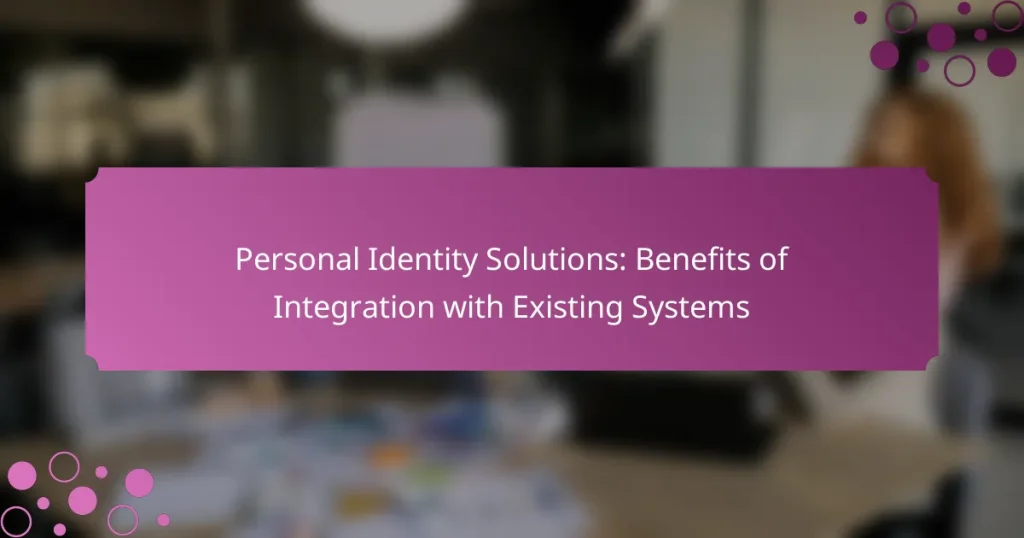Integrating personal identity solutions with existing systems in the UK significantly enhances security and user experience while ensuring compliance with regulations. By utilizing advanced verification methods, organizations can protect sensitive data and reduce the risk of unauthorized access. This integration not only streamlines operations but also fosters user trust, making identity management more efficient and effective.
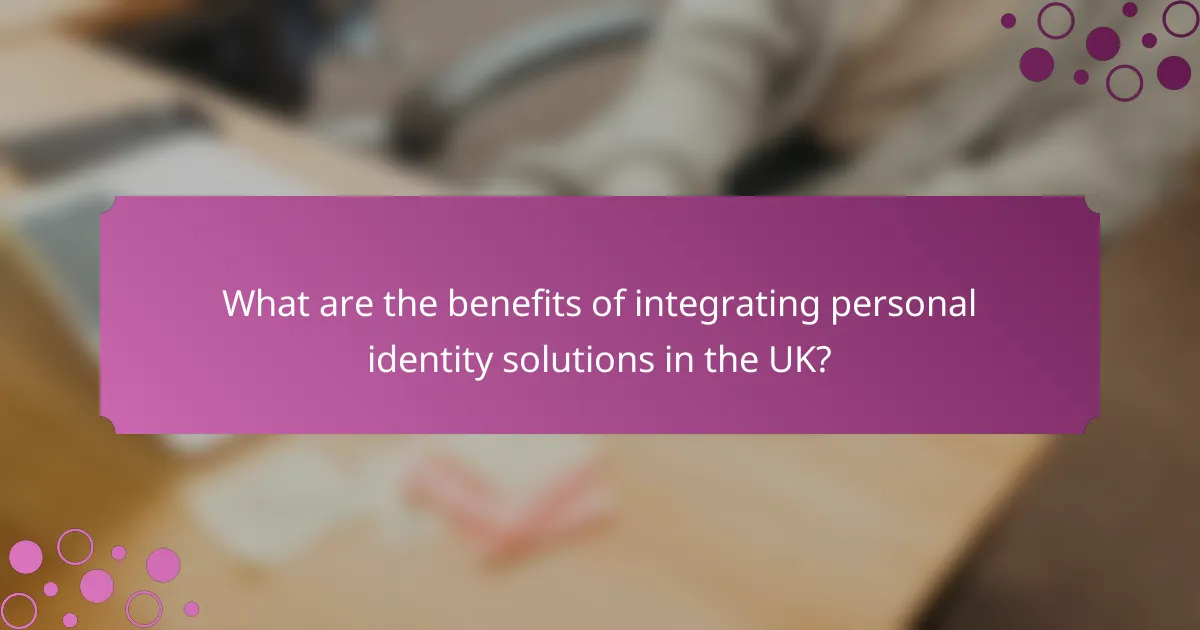
What are the benefits of integrating personal identity solutions in the UK?
Integrating personal identity solutions in the UK offers enhanced security, improved user experiences, streamlined operations, and better compliance with regulations. These benefits help organizations manage identities more effectively while ensuring user trust and operational efficiency.
Enhanced security measures
Integrating personal identity solutions significantly boosts security by utilizing advanced authentication methods such as biometrics and multi-factor authentication. This reduces the risk of unauthorized access and identity theft, which are critical concerns in today’s digital landscape.
Organizations can implement real-time monitoring and anomaly detection systems to identify suspicious activities quickly. By integrating these security features, companies can protect sensitive information and maintain user confidence.
Improved user experience
Personal identity solutions streamline the login process, allowing users to access services with minimal friction. Features like single sign-on (SSO) enable users to authenticate once and gain access to multiple applications, enhancing convenience.
Moreover, personalized experiences can be created based on user data, leading to higher satisfaction and engagement. Users appreciate seamless interactions, which can lead to increased loyalty and retention rates.
Streamlined operations
Integrating identity solutions can automate various administrative tasks, such as user provisioning and de-provisioning, which saves time and reduces errors. This efficiency allows IT teams to focus on more strategic initiatives rather than routine maintenance.
Additionally, centralized identity management systems simplify the onboarding process for new employees, ensuring they have the necessary access from day one. This operational efficiency can lead to significant cost savings over time.
Regulatory compliance
In the UK, organizations must comply with regulations such as the General Data Protection Regulation (GDPR) and the Data Protection Act. Integrating personal identity solutions helps ensure that user data is handled securely and in accordance with these laws.
By implementing robust identity management practices, companies can demonstrate compliance through better data governance and reporting capabilities. This not only mitigates legal risks but also enhances the organization’s reputation in the marketplace.

How do personal identity solutions improve security?
Personal identity solutions enhance security by implementing advanced verification methods and protecting sensitive data. They help organizations reduce the risk of unauthorized access and data breaches, ensuring that only verified users can access critical systems and information.
Multi-factor authentication
Multi-factor authentication (MFA) significantly boosts security by requiring users to provide two or more verification factors to gain access. This could include something they know (a password), something they have (a smartphone app or hardware token), or something they are (biometric data). By combining these factors, MFA makes it much harder for attackers to compromise accounts.
When implementing MFA, consider using widely accepted methods such as SMS codes, authenticator apps, or biometric scans. Organizations should also ensure that users are educated about the importance of MFA and how to set it up properly to avoid common pitfalls, such as relying solely on SMS for verification, which can be vulnerable to interception.
Data encryption techniques
Data encryption techniques protect sensitive information by converting it into a format that is unreadable without the proper decryption key. This ensures that even if data is intercepted during transmission or accessed without authorization, it remains secure and unusable to unauthorized parties. Common encryption standards include AES (Advanced Encryption Standard) and RSA (Rivest-Shamir-Adleman).
When choosing encryption methods, consider the type of data being protected and regulatory requirements that may apply, such as GDPR in Europe or HIPAA in the United States. Regularly updating encryption protocols and keys is crucial to maintaining security, as outdated methods can become vulnerable to new threats.
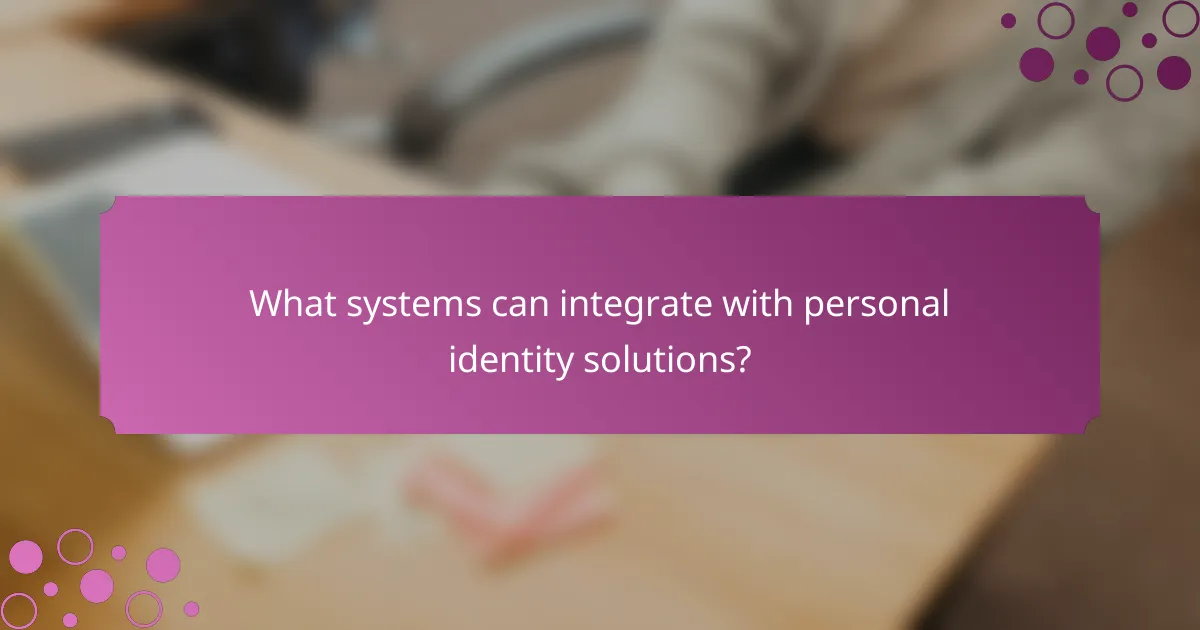
What systems can integrate with personal identity solutions?
Personal identity solutions can integrate with various systems to enhance security and streamline user management. Key systems include customer relationship management (CRM), enterprise resource planning (ERP), and identity and access management (IAM) systems, each serving distinct functions in an organization.
Customer relationship management (CRM) systems
Integrating personal identity solutions with CRM systems allows businesses to manage customer data more effectively. This integration helps in personalizing customer interactions and improving service delivery by ensuring that user identities are verified and securely stored.
When considering integration, ensure that the CRM system supports APIs or connectors for seamless data exchange. Popular CRM platforms like Salesforce or HubSpot typically offer such functionalities, making it easier to implement identity solutions.
Enterprise resource planning (ERP) systems
ERP systems benefit from personal identity solutions by enhancing data security across various business functions. By integrating these solutions, organizations can ensure that only authorized personnel access sensitive information, which is crucial for compliance with regulations like GDPR.
To effectively integrate, assess the ERP system’s compatibility with identity solutions. Systems like SAP or Oracle often provide built-in features or modules that facilitate this integration, allowing for centralized user management and streamlined workflows.
Identity and access management (IAM) systems
Integrating personal identity solutions with IAM systems is essential for managing user access and ensuring security. This combination allows organizations to enforce policies that govern who can access what resources, significantly reducing the risk of unauthorized access.
When implementing this integration, focus on ensuring that the IAM system supports multi-factor authentication and single sign-on capabilities. Solutions like Okta or Microsoft Azure Active Directory are popular choices that can enhance security while simplifying user access across platforms.
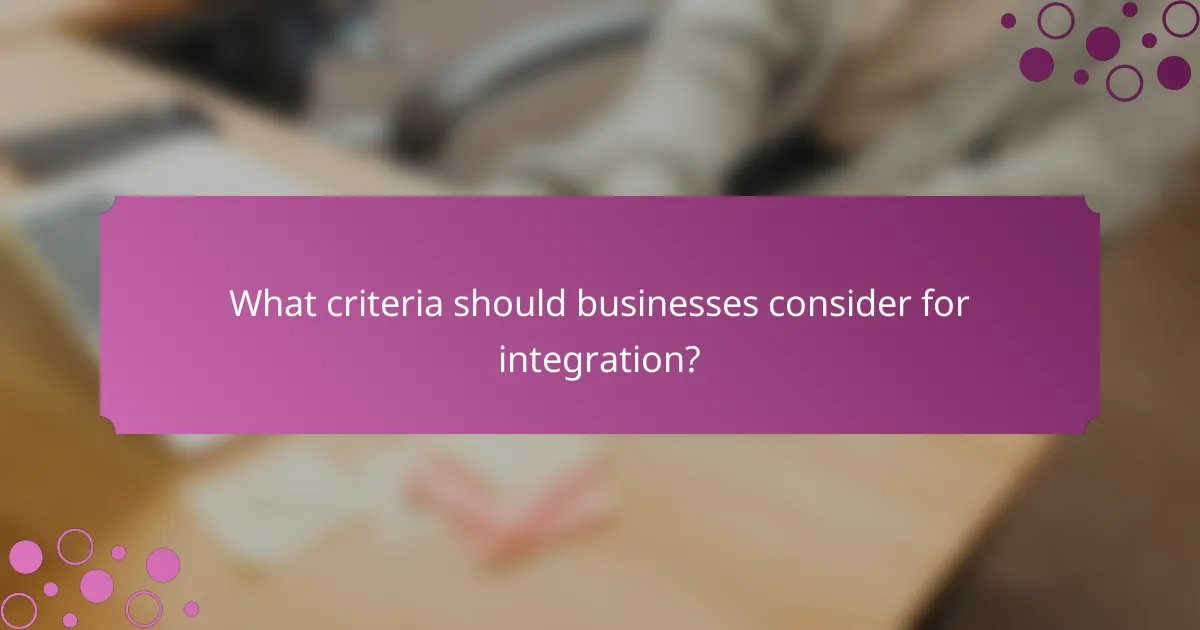
What criteria should businesses consider for integration?
Businesses should evaluate compatibility, scalability, and security when integrating personal identity solutions with existing systems. These criteria ensure that the integration process is seamless, future-proof, and secure, ultimately enhancing operational efficiency.
Compatibility with existing infrastructure
Compatibility is crucial for a successful integration of personal identity solutions. Businesses must assess whether the new system can work with their current hardware, software, and network configurations. This includes checking for support of existing data formats and APIs.
For example, if a company uses a specific customer relationship management (CRM) system, the new identity solution should easily connect with it without requiring extensive modifications. Conducting a compatibility audit can help identify potential issues early in the process.
Scalability of the solution
Scalability refers to the ability of the identity solution to grow alongside the business. A scalable system can handle increased user loads and data volumes without sacrificing performance. Businesses should consider whether the solution can accommodate future growth, such as expanding to new markets or adding new features.
When evaluating scalability, look for solutions that offer flexible pricing models and modular features. This allows businesses to pay for only what they need initially, with the option to expand as requirements evolve. A good rule of thumb is to choose a solution that can support at least double the current user base for the next few years.

How can businesses in the UK choose the right personal identity solution?
Businesses in the UK can choose the right personal identity solution by assessing their specific needs, understanding integration capabilities, and evaluating vendor options. Key considerations include compliance with local regulations, user experience, and the ability to seamlessly integrate with existing systems.
Assessing vendor reputation
To assess vendor reputation, businesses should research the history and credibility of potential identity solution providers. Look for vendors with a proven track record in the UK market, as well as certifications that demonstrate compliance with industry standards, such as ISO 27001 for information security management.
Consider reaching out to industry peers for recommendations and insights. A vendor with a strong reputation often has positive case studies and testimonials that highlight their effectiveness in similar business contexts.
Evaluating user reviews
User reviews provide valuable insights into the functionality and reliability of personal identity solutions. Check platforms like Trustpilot or G2 for authentic feedback from current users, focusing on aspects such as ease of use, customer support, and integration experiences.
Pay attention to common themes in reviews, both positive and negative. This can help identify potential pitfalls or advantages that may not be apparent during initial vendor assessments. Aim for solutions with a high percentage of favorable reviews to ensure a better user experience.

What are the costs associated with personal identity solutions?
The costs associated with personal identity solutions can vary widely based on the complexity of the system and the specific features required. Key expenses typically include initial setup costs and ongoing maintenance fees, both of which are crucial for budgeting and planning.
Initial setup costs
Initial setup costs for personal identity solutions can range from a few thousand to tens of thousands of dollars, depending on the scale and technology involved. Factors influencing these costs include software licensing, hardware requirements, and integration with existing systems.
When planning for initial expenses, consider potential customization needs and whether third-party services will be required. It’s advisable to obtain multiple quotes from vendors to compare offerings and ensure you are getting the best value.
Ongoing maintenance fees
Ongoing maintenance fees for personal identity solutions typically include software updates, technical support, and system monitoring. These costs can be structured as monthly subscriptions or annual fees, often ranging from hundreds to several thousand dollars per year.
To manage these ongoing expenses effectively, organizations should budget for regular reviews of their identity solution’s performance and scalability. This proactive approach helps identify any necessary upgrades or adjustments, ensuring the system remains efficient and secure over time.
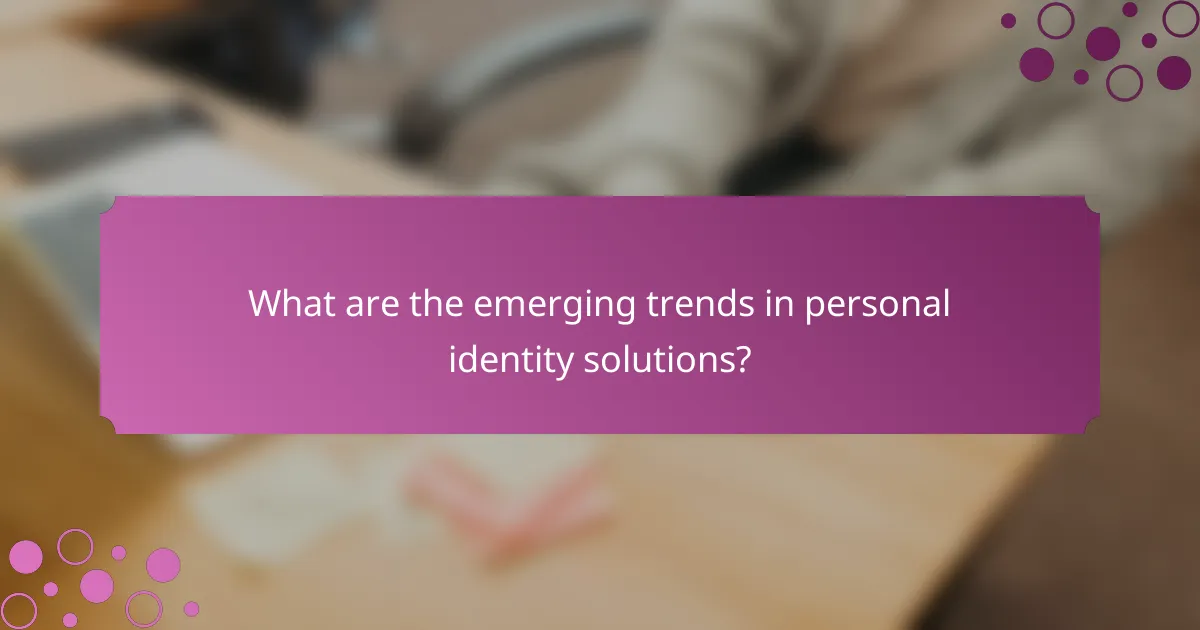
What are the emerging trends in personal identity solutions?
Emerging trends in personal identity solutions focus on enhancing security and user experience through advanced technologies. Key developments include the integration of artificial intelligence and improvements in biometric authentication methods.
Use of artificial intelligence
Artificial intelligence (AI) is transforming personal identity solutions by enabling more accurate identity verification processes. AI algorithms can analyze vast amounts of data to detect anomalies and predict fraudulent activities, thereby enhancing security measures.
Organizations are increasingly adopting AI-driven identity management systems that streamline user verification. These systems can reduce processing times significantly, often completing identity checks in just a few seconds, compared to traditional methods that may take minutes.
Biometric authentication advancements
Biometric authentication is becoming more sophisticated, with advancements in fingerprint, facial recognition, and iris scanning technologies. These methods provide a higher level of security compared to traditional passwords, as they rely on unique physical traits that are difficult to replicate.
Recent developments have improved the accuracy and speed of biometric systems, making them more user-friendly. For instance, modern facial recognition systems can authenticate users in low-light conditions and from various angles, enhancing usability in real-world applications.
